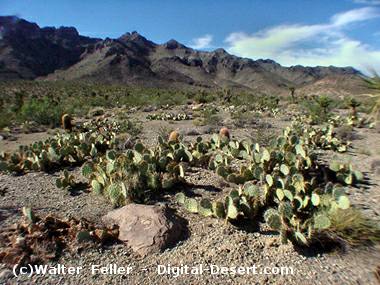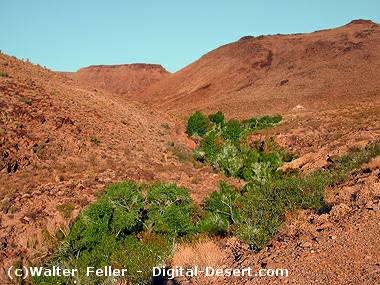Flora & Fauna
Flora
The Mojave National Preserve offers a landscape of almost unparalleled ecological diversity, whose elevations range from very low, such as in Zzyzx, at 938 feet, to a high of Clark Mountain, which reaches 7,929 feet, and whose desert environment is peculiarly well adapted. This is partly because of the varying elevations and part where the deserts intersect: Mojave, Great Basin, and Sonoran Deserts. Thus, the plant species are divergent here and specialized enough to survive the harsh conditions in the desert.
Scattered throughout the Preserve, at higher points, one can see relict stands of white fir, juniper, and pinyon pines that favour the cooler, more protected areas. The lower areas are dominated by yuccas, Joshua trees, and cholla cacti adapted to the arid, sun-drenched desert floor. These really are examples of how hardy desert plants can be; many have come up with spectacular adaptations to survive at the hot and cold temperatures as well as lack of water.
One of the better-known plants in the Mojave Desert is the Joshua tree, Yucca brevifolia jaegeriana. This famous desert plant has a special place in the landscape, growing between 3,000 and 7,000 feet. Named by Mormon settlers who saw the spiny limbs of the tree as resembling the biblical figure Joshua with his arms raised in prayer, Joshua trees have become symbolic of the desert. Although they are slow-growing, they live to 150 years and provide nourishment for wildlife such as Scott's oriole and northern flicker. As small plants, Joshua trees are protected by 'nurse plants', but as older plants, the spiny limbs make it possible for them to grow independently.
Another highly adaptable desert plant is the creosote shrub (Larrea tridentata) which is actually the most common plant in the Mojave National Preserve. It grows at elevations up to 4,000 feet and can be found in each of the four southwestern deserts. The creosote is considered one of the oldest living things on Earth with calculations placing the age of some creosote rings between 11,000 and 14,000 years. Native people, including the Pima, have used creosote gum medicinally for generations by chewing the resin to treat stomach ailments and dysentery.
Other vegetation of interest in the Preserve is the cholla cacti, which falls into the cactus family or Cactocea. The chollas have adapted to a unique mode of photosynthesis called CAM photosynthesis. It enables them to save water by keeping their stomata (pores meant for gas exchange) closed during the peak periods of the day. Thus, it helps them withstand extreme heat in the deserts. Additionally, cholla are the only cacti to feature protective sheaths over their spines, further protecting the plant from the harsh desert sun.
Throughout the Mojave National Preserve, plants have adapted to water scarcity in various ways. Many annual plants, such as wildflowers and grasses, take advantage of the short rainy seasons during the winter and spring months when it is possible to hurry through their life cycles, painting the dry landscape with vibrant colour. Shrubs typically go dormant and lose their leaves to conserve water, while most cacti store water in succulent stems, the spines shading and reducing water loss.
Water from these more abundant sources-springs and seeps-allows for healthier riparian vegetation growth, creating unique and important resources for wildlife. These wet areas, in particular, are key to migratory birds using the vegetation as a food source and for temporary shelter during their migration periods.
Overall, the Mojave National Preserve is evidence of deserts being able to support plant life that adapts and survives within them. With 803 identified species of plants from 85 different plant families, the Preserve offers a rich and varied landscape whereby each species has found its own particular way to succeed in the challenging desert environment. From ancient creosote shrubs to towering Joshua trees, Mojave plants bear witness to incredible capability on the part of nature to survive and flourish in extreme conditions.

Pancake Prickly Pear

Piute Creek